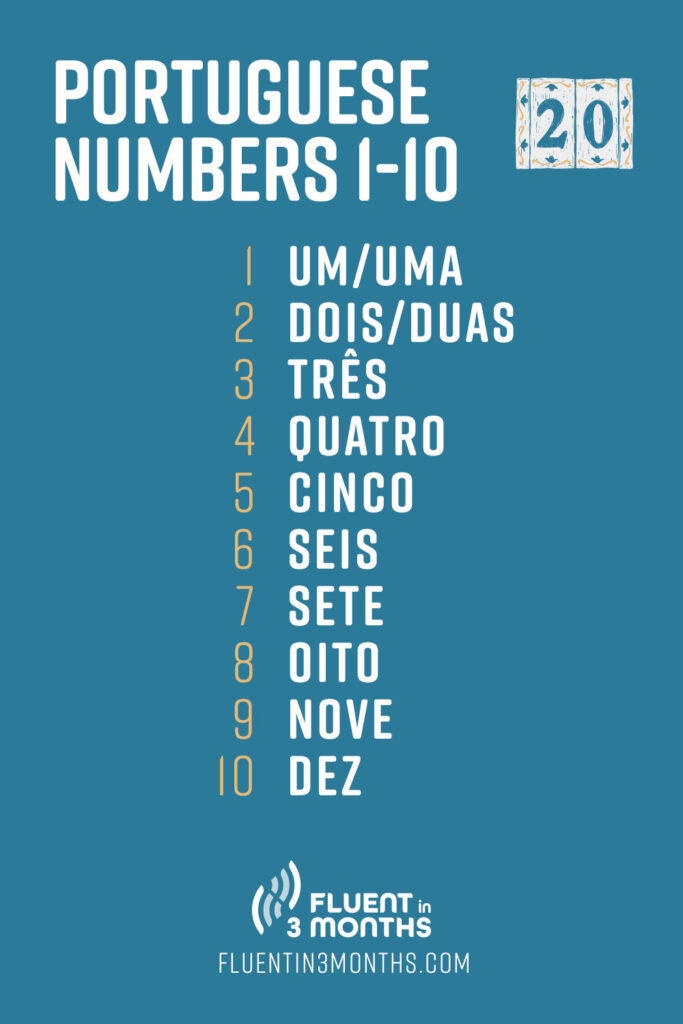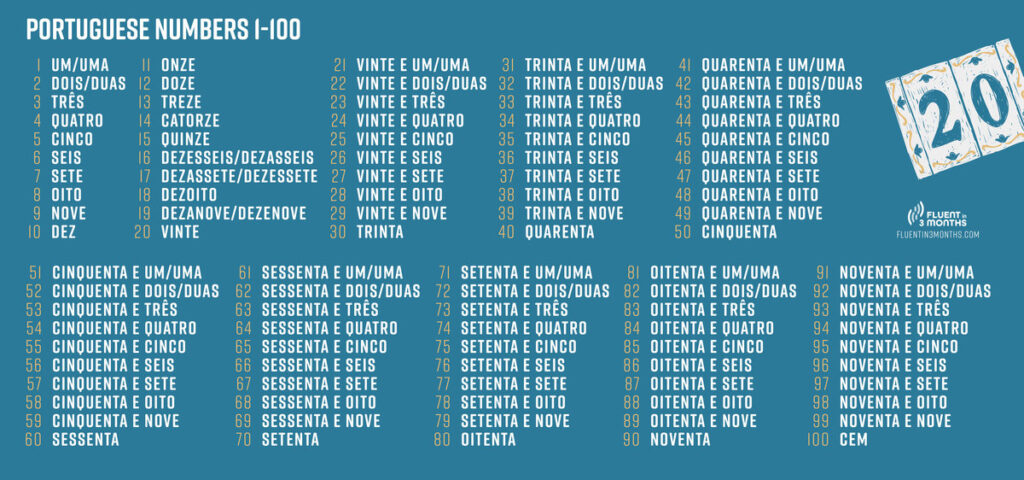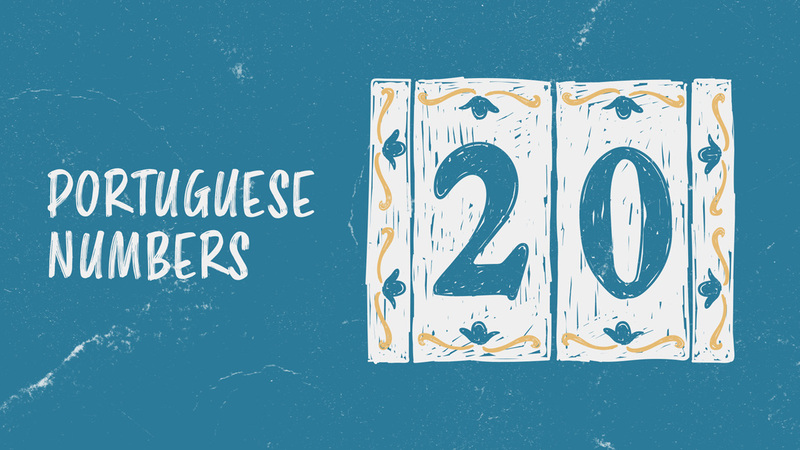Numbers in Portuguese: Counting in Portuguese from 1-100+
If you want to learn how to count in Portuguese, you’re in the right place. This article will give you everything you need for a complete understanding of Portuguese numbers.
I’ll cover both cardinal and ordinal numbers (that is, both “one, two, three…” and “first, second, third…”), along with all the subtleties and irregularities that you need to know.
The goal? To give you a comprehensive guide to Portuguese numbers so that, by the time you’re done, you won’t have any questions left about numbers and counting in Portuguese!
Before we get into the article, if you are interested in learning Portuguese yourself, you should check out my absolute favourite resource for learning Portuguese, PortuguesePod101.
Every time I refresh my Portuguese, this has been by far my favourite resource, since it’s a podcast style learning resource that covers many aspects of the language much better than traditional courses do.
It also tackles the issue of listening comprehension better than literally anything else out there, since its catalogue of lessons eases you in with simple lessons at first that get progressively harder, and you can listen to them for a huge range of topics better suited to your hobbies and interests.
They have a free option for anyone who wants to test them out, based on just their limited recent episodes, but exclusively for Fi3M readers, you can get 20% off if you sign-up for any of their subscriptions, which allow you to access their full catalog of many hundreds of lessons, using the code FLUENT3.
I highly recommend this to all Portuguese learners!!
Portuguese Numbers 1-10
If you’ve just started learning Portuguese, you don’t need to learn how to count to a million just yet.
So let’s leave the huge numbers until later, and start with the basics. The first ten numbers in Portuguese are:
- 1 – um/uma
- 2 – dois/duas
- 3 – três
- 4 – quatro
- 5 – cinco
- 6 – seis
- 7 – sete
- 8 – oito
- 9 – nove
- 10 – dez
As you can see “one” (um/uma) and “two” (dois/duas) have two versions. These are the masculine and feminine forms of the number, and they need to agree with the gender of the thing that’s being counted:
- comprei um limão – “I bought one lemon”
- tenho dois cachorros – “I have two dogs”
- você pode me passar uma taça” – “Can you pass me one cup?”
- te contei duas vezes já – “I already told you two times”
Note that um/uma can mean “a” as well as “one”. Portuguese doesn’t distinguish between these two words like English does. So, for example, the first sentence above could also be translated as simply “I bought a lemon”.

Portuguese Numbers 11-19
Ready for round two? Here’s the next batch of Portuguese numbers you should learn:
- 11 – onze
- 12 – doze
- 13 – treze
- 14 – catorze
- 15 – quinze
- 16 – dezesseis/dezasseis
- 17 – dezessete/dezassete
- 18 – dezoito
- 19 – dezenove/dezanove
Pro tip: Where I’ve written two words for one number, it’s because the first version is used in Brazil and the second is used in Portugal. So, for example, Brazilians say dezesseis while Portuguese people say dezasseis.
To help you remember these, notice that the numbers 16 to 19 are formed using the same, simple pattern.
For example dezesseis is just the combination of dez (“ten”) and seis (“six”), with an e (“and”) in the middle. The only thing you need to remember is that Portuguese people change the e to an a (don’t ask me why), and that dezoito is a slight exception because it drops the e entirely.
You may be wondering why dezesseis and dezessete have that extra s in the middle. Why isn’t it dezeseis and dezesete?
It’s because of the rules of Portugues spelling and pronunciation.
An s is normally pronounced like the English letter “s”, but when it comes between two vowels it’s pronounced like an English “z”. However, a double s is always pronounced like an English “s”. So if you just wrote dezesete, you’d be changing the s in sete to sound like a z.
By doubling it up to dezessete, you make it clear that the sete still sounds the same as if it were a separate word.
Portuguese numbers 20-100
Once you’ve learned the first nineteen numbers in Portuguese, it’s easy to learn the next eighty. All you need to do is remember the multiples of ten:
- 20 – vinte
- 30 – trinta
- 40 – quarenta
- 50 – cinquenta
- 60 – sessenta
- 70 – setenta
- 80 – oitenta
- 90 – noventa
These aren’t hard to learn, especially if you notice that all of them from 40 upwards end in -enta, and all of them except vinte have an obvious relationship with their root digit: oito and oitenta.
Now, to say a number like 43, you pick the right multiple of ten (in this case quarenta), translate the number from the units column (in this case três), and join them together with an e – quarenta e três. Unlike with dezessete, you write this as three separate words. And Portuguese people don’t change the e to an a.
This pattern is the same for all numbers between twenty and ninety-nine. So all you need to know now is that cem means “one hundred” – and you know how to count from 1 to 100 in Portuguese.
Check this table if you’re not sure:
| 1 – um/uma | 11 – onze | 21 – vinte e um/uma | 31 – trinta e um/uma | 41 – quarenta e um/uma | 51 – cinquenta e um/uma | 61 – sessenta e um/uma | 71 – setenta e um/uma | 81 – oitenta e um/uma | 91 – noventa e um/uma |
| 2 – dois/duas | 12 – doze | 22 – vinte e dois/duas | 32 – trinta e dois/duas | 42 – quarenta e dois/duas | 52 – cinquenta e dois/duas | 62 – sessenta e dois/duas | 72 – setenta e dois/duas | 82 – oitenta e dois/duas | 92 – noventa e dois/duas |
| 3 – três | 13 – treze | 23 – vinte e três | 33 – trinta e três | 43 – quarenta e três | 53 – cinquenta e três | 63 – sessenta e três | 73 – setenta e três | 83 – oitenta e três | 93 – noventa e três |
| 4 – quatro | 14 – catorze | 24 – vinte e quatro | 34 – trinta e quatro | 44 – quarenta e quatro | 54 – cinquenta e quatro | 64 – sessenta e quatro | 74 – setenta e quatro | 84 – oitenta e quatro | 94 – noventa e quatro |
| 5 – cinco | 15 – quinze | 25 – vinte e cinco | 35 – trinta e cinco | 45 – quarenta e cinco | 55 – cinquenta e cinco | 65 – sessenta e cinco | 75 – setenta e cinco | 85 – oitenta e cinco | 95 – noventa e cinco |
| 6 – seis | 16 – dezesseis/dezasseis | 26 – vinte e seis | 36 – trinta e seis | 46 – quarenta e seis | 56 – cinquenta e seis | 66 – sessenta e seis | 76 – setenta e seis | 86 – oitenta e seis | 96 – noventa e seis |
| 7 – sete | 17 – dezassete/dezessete | 27 – vinte e sete | 37 – trinta e sete | 47 – quarenta e sete | 57 – cinquenta e sete | 67 – sessenta e sete | 77 – setenta e sete | 87 – oitenta e sete | 97 – noventa e sete |
| 8 – oito | 18 – dezoito | 28 – vinte e oito | 38 – trinta e oito | 48 – quarenta e oito | 58 – cinquenta e oito | 68 – sessenta e oito | 78 – setenta e oito | 88 – oitenta e oito | 98 – noventa e oito |
| 9 – nove | 19 – dezanove/dezenove | 29 – vinte e nove | 39 – trinta e nove | 49 – quarenta e nove | 59 – cinquenta e nove | 69 – sessenta e nove | 79 – setenta e nove | 89 – oitenta e nove | 99 – noventa e nove |
| 10 – dez | 20 – vinte | 30 – trinta | 40 – quarenta | 50 – cinquenta | 60 – sessenta | 70 – setenta | 80 – oitenta | 90 – noventa | 100 – cem |
Note that for all numbers which end in one or two, you need to use the correct form of um/uma or dois/duas:
- Somos vinte e duas pessoas – “There are twenty-two of us.” (literally: “We’re twenty-two people.”)
- Li trinta e um livros esse ano já – “I’ve already read thirty-one books this year.”
The number zero, by the way, is zero. That one’s easy to remember!

“Cem” vs “Cento” in Portuguese
I told you that cem means “one-hundred”, but this isn’t the full story. You actually only use cem when you have exactly one-hundred of something. If another number comes after the cem, you should instead use cento:
- 100 – cem
- 101 – cento e um/uma
- 138 – cento e trinta e oito
Makes sense?
If precision doesn’t matter, and you just want to say that you have “hundreds” of something, use centenas:
Numbers up to 1,000 in Portuguese
Earlier, we learned the Portuguese words for the multiples of ten, which allowed us to say any number up to one hundred.
It’s time to level-up. This time, we must learn the Portuguese words for the multiples of 100. Once we’re done, we’ll know how to say any number up to one thousand!
The numbers 200, 300, etc. have masculine and feminine forms, meaning they must agree with the noun they appear next to. Masculine forms end in -os and feminine forms in -as:
- 200 – duzentos/duzentas
- 300 – trezentos/trezentas
- 400 – quatrocentos/quatrocentas
- 500 – quinhentos/quinhentas
- 600 – seiscentos/seiscentas
- 700 – setecentos/setecentas
- 800 – oitocentos/oitocentas
- 900 – novecentos/novecentas
As you can see, these generally follow the pattern number + centos. E.g. nine-hundred is nove (nine) + centos/centas (hundreds). The only ones that don’t follow this pattern exactly are duzentos, trezentos, and quinhentos, but they’re not too far off.
Separate the hundreds, units, and tens portion of any number with an e:
- 121 – cento e vinte e um
- 487 – quatrocentos e oitenta e sete
- 701 – setecentos e um
- 811 – oitocentos e onze
- 940 – novecentos e quarenta
Numbers Above 1000 in Portuguese
It’s time to bring out the big guns.
Mil means “(one) thousand” and um milhão means “one million”. Milhão becomes milhões in the plural, while mil doesn’t change. So you’d say dois mil (2,000) but dois milhões (2,000,000).
You don’t normally need an e when linked hundreds and thousands, e.g.:
- 1,234 – mil duzentos e quatro
- 2,058 – dois mil cincuenta e oito
However, you do need to insert an e if the number is an exact multiple of one hundred:
- 1,200 – mil e duzentos
- 2,400 – dois mil e quatrocentos
Finally, you need an e when linking thousands and units:
- 2,004 – dois mil e quatro
- 5,009 – cinco mil e nove
Also note that when using milhões, you don’t have “a million things” (um milhão coisas), you have “a million of things”: um milhão de coisas.
What about numbers above one million, like a billion and a trillion?
Things might seem like they start to get complicated, but I’ll help you make sense out of them.
Millions and Billions (Long vs Short Scale Numbers) in Portuguese
You may know that “a billion” used to have a different meaning in British and American English. To Americans, a “billion” meant “one thousand million”, like it does today.
In Britain and most other English-speaking countries, a billion meant “one million million” – which today everyone (in the English-speaking world at least) calls a “trillion”.
Similarly, “a trillion” had its current meaning in the U.S. of “one million million”. Everywhere else it meant “one million million million” – that’s a one with a whopping eighteen zeroes afterward.
At some point in the twentieth century, non-Americans gave up and started using “billion” and “trillion” in the American way. (We’re still waiting for Americans to return the favour and stop measuring temperature in Fahrenheit.) The “old” way is called the long scale numbering system, while the modern/American way is called the short scale.
You may be wondering how any of this is relevant to Portuguese.
Well, in many languages they still use the long scale system, in which a billion and a million (actually their cognates in the local language) have twelve and eighteen zeros, respectively. So, for example, in Spanish a billón means 1,000,000,000,000.
Which one does Portuguese use? Most Portuguese-speaking countries use the long-scale system, with the exception of Brazil.
So um bilhão means “1,000,000,000” in Brazil, but “1,000,000,000,000” in Portugal or Angola.
To add yet another complication, bilhão can alternatively be spelled bilião. The former is more common in Brazil, while the latter is more common in Portugal.
Fun fact: you know how in English we have “a zillion” as a humourous way of saying “a very large number”? In Portuguese you can do the same thing with um zilhão.
Decimal Points and Commas in Portuguese Numbers
In English, we make long numbers more readable by putting a comma in between each group of three digits: e.g. one million is written “1,000,000”.
On the other hand, for fractional numbers, we separate the integer part from the rest using a dot (the “decimal point”): e.g. 3.14159.
In Portuguese, however, as in most European languages, they do things the other way around. Big numbers are split up using dots, and fractional numbers are written using a decimal comma – the vírgula da casa decimal:
- A população do Brasil e 208.494.900
- O valor de pi é 3,1419
You could also use spaces instead of dots to split up a large number, although this is less common:
- A população do Brasil e 208 494 900
Vírgula means “comma”, and a number like “2,34” would be read out loud as dois vírgula trinta e quatro.

This is me in July 2022, making the population of Brazil go up by one. It was my first nomadic move after living in the USA!
Names of Years in Portuguese.
In English, there are two ways to say “1999”. If you’re talking about the year, you’d say “nineteen ninety-nine”. In other cases where you’re just referring to the number, you’d say “one thousand, nine-hundred and ninety-nine”.
In Portuguese, to say the same of the year you just say the regular name of the number. So the year 1999 in Portuguese is mil novecentos, noventa e nove.
Ordinal Numbers in Portuguese
So far we’ve only looked at cardinal numbers – “one, two, three”, etc.
The other thing you need to know about is the ordinal numbers – “first, second, third”, etc… Here they are:
- 1st – primeiro
- 2nd – segundo
- 3rd – terceiro
- 4th – quarto
- 5th – quinto
- 6th – sexto
- 7th – sétimo
- 8th – oitavo
- 9th – nono
- 10th – décimo
These words function like regular adjectives, meaning they need to agree in gender and number with the word they refer to:
- o primeiro homem – “the first man”
- a segunda pessoa – “the second person”
- os terceiros países – “the third countries”
- as quartas maçãs – “the fourth apples”
You also need to know the ordinal numbers for multiples of 10:
- 20th – vigésimo
- 30th – trigésimo
- 40th – quadragésimo
- 50th – quinquagésimo
- 60th – sexagésimo
- 70th – septuagésimo
- 80th – octogésimo
- 90th – nonagésimo
- 100th – centésimo
Then you can combine these words to get other numbers:
- 11th – décimo primeiro
- 34th – trigésimo quarto
Simple! However, when it comes to the bigger ordinal numbers, especially ones that are not exact multiples of ten, people tend to avoid them in informal speech, and instead use a cardinal number:
- Hoje foi o dia sessenta e sete da minha dieta – “Today was the 67th day (lit: day 67) of my diet”
“Meia” in Brazilian Portuguese
One final thing is worth knowing. In Brazil (but not so much in Portugal), you’ll often hear people saying the word meia when reading a list of numbers. This is an alternative way of saying “six”, and it comes from meia dúzia – “half dozen”.
It’s like how in English we often say “oh” instead of “zero”, for example when reading out a phone number. Brazilians do the same, except they replace seis with meia.
Phew, you’ve finally tackled this introduction to counting in Portuguese. You’re on the right track! If you want to learn the Portuguese numbers more quickly, you can take a leaf out of my book and use Anki’s spaced repetition system! It’s a fantastic way to learn vocabulary more efficiently.
Let me know on Instagram (@irishpolyglot), TikTok (@irishpolyglot), or Twitter (@irishpolyglot) what method you will use!
If you’re ready to continue your Portuguese mission, check out one of these articles:



Social